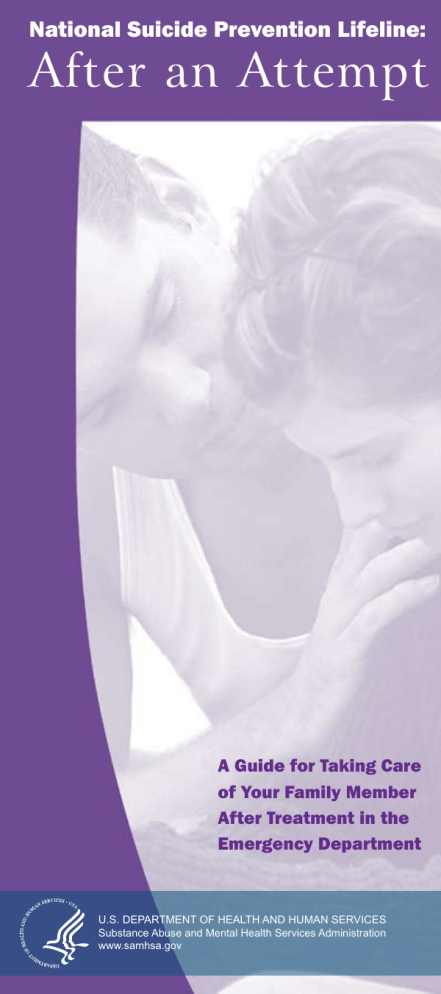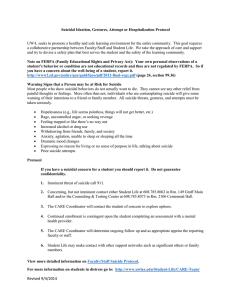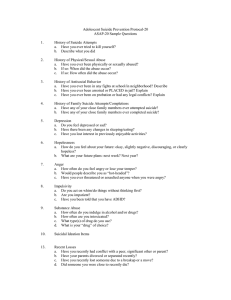After an Attempt National Suicide Prevention Lifeline: A Guide for Taking Care
advertisement

National Suicide Prevention Lifeline: After an Attempt A Guide for Taking Care of Your Family Member After Treatment in the Emergency Department U.S. DEPARTMENT OF HEALTH AND HUMAN SERVICES Substance Abuse and Mental Health Services Administration www.samhsa.gov If you are in crisis, please call: National Suicide Prevention Lifeline 1-800-273-TALK (8255) En español: 1-888-628-9454 TTY: 1-800-799-4889 www.suicidepreventionlifeline.org National Suicide Prevention Lifeline: After an Attempt A Guide for Taking Care of Your Family Member After Treatment in the Emergency Department Acknowledgements This brochure was originally developed by the National Alliance on Mental Illness (www.nami.org) in partnership with the Suicide Prevention Resource Center (www.sprc.org) under Grant Number 1.U79 SM55029-01 from the Substance Abuse and Mental Health Services Administration (SAMHSA), U. S. Department of Health and Human Services (HHS). The views, policies, and opinions expressed are those of the authors and do not necessarily reflect those of SAMHSA or HHS. Public Domain Notice All material appearing in this publication is in the public domain and may be reproduced or copied without permission from SAMHSA or the Center for Mental Health Services. Citation of the source is appreciated. This publication may not be reproduced or distributed for a fee without the specific, written authorization of the Office of Communications, SAMHSA, HHS. Electronic Access and Copies of Publication This publication can be accessed electronically through www.mentalhealth.samhsa.gov. For additional free copies of this document, please contact SAMHSA’s National Mental Health Information Center at www.mentalhealth.samhsa. gov, 1-800-789-2647, or 1-866-889-2647 (TDD). Ask for Publication No. CMHS-SVP-0159. Recommended Citation U.S. Department of Health and Human Services. National Suicide Prevention Lifeline: After an Attempt. A Guide for Taking Care of Your Family Member After Treatment in the Emergency Department. CMHS-SVP-0159, Rockville, MD: Center for Mental Health Services, Substance Abuse and Mental Health Services Administration, 2006. Originating Office Substance Abuse and Mental Health Services Administration 1 Choke Cherry Road Rockville, MD 20857 CMHS-SVP-0159 Printed 2006 Family Guide for Your Family Member in the Emergency Department S uicidal thoughts and actions generate conflicting feelings in family members who love the person who wishes to take his or her own life. That is why this guide was developed for you. It will give you some important points on how to take care of yourself and your family member following a suicide attempt and it will provide resources to help you move forward. What Happens in the Emergency Department Goal The goal of an emergency department visit is to get the best outcome for the person at a time of crisis—resolving the crisis, stabilizing the patient medically and emotionally, and making recommendations and referrals for followup care or treatment. There are several steps in the process, and they all take time. When someone is admitted to an emergency department for a suicide 1 attempt, a doctor will evaluate the person’s physical and mental health. Emergency department staff should look for underlying physical problems that may have contributed to the suicidal behavior, such as side effects from medications, untreated medical conditions, or the presence of street drugs that can cause emotional distress. While emergency department staff prefer to assess people who are sober, they should not dismiss things people say or do when intoxicated, especially comments about how they might harm themselves or others. Assessment After emergency department staff evaluate your family member’s physical health, a mental health assessment should be performed, and the physician doing the exam should put your relative’s suicidal behavior into context. The assessment will generally focus on three areas: 1. What psychiatric or medical conditions are present? Are they being or have they been treated? Are the suicidal thoughts and behavior a result of a recent change, or are they a longstanding condition? 2. What did the person do to harm himself or herself? Have there been previous attempts? Why did the person act, and why now? What current stressors, including financial or relationship losses, may have contributed to this decision? Does the person regret surviving the suicide 2 attempt? Is the person angry with someone? Is the person trying to reunite with someone who has died? What is the person’s perspective on death? 3. What support systems are there? Who is providing treatment? What treatment programs are a good match for the person? What does the individual and the family feel comfortable with? Finally, a doctor may assess in more detail the actual suicide attempt that brought your relative into the emergency department. Information that the treatment team should look for includes the presence of a suicide note, the seriousness of the attempt, or a history of previous suicide attempts. Inform the emergency department personnel if your relative has: •A ccess to a gun, lethal doses of medications, or other means of suicide. • Stopped taking prescribed medicines. • Stopped seeing a mental health provider or physician. • Written a suicide note or will. • Given possessions away. • Been in or is currently in an abusive relationship. • An upcoming anniversary of a loss. • Started abusing alcohol or drugs. • Recovered well from a previous suicidal crisis following a certain type of intervention. 3 What the Emergency Department Needs To Know: How You Can Help Confidentiality and Information Sharing Family members are a source of history and are often key to the discharge plan. Provide as much information as possible to the emergency department staff. Even if confidentiality laws prevent the medical staff from giving you information about your relative, you can always give them information. Find out who is doing the evaluation and talk with that person. You can offer information that may influence the decisions made for your relative. If you ever again have to accompany your relative to the emergency department after an attempt, remember to bring all medications, suspected causes of overdose, and any names and phone numbers of providers who may have information. Emergency department personnel should try to contact the medical professionals who know the situation best before making decisions. Other important information about your relative’s history to share with the emergency department staff include: • A family history of actual suicide—mental health professionals are taught to pay attention to this because there is an 4 increased risk in families with a history of suicide. • Details about your relative’s treatment team—a recent change in medication, the therapist is on vacation, etc. This information is relevant for emergency department staff because if they do not feel hospitalization is best, they need to discharge your family member to a professional’s care. • If the person has an advance directive1, review this with the emergency department treatment team. If you have a guardianship, let them know that as well. You may want to get permission from the staff and your relative to sit in on your relative’s evaluation in the emergency department to listen and add information as needed. Your role is to balance the emergency department staff ’s training and the interview of the patient with your perspective. The best emergency department decisions are made with all the relevant information. 1 Advance directives are legal documents that allow someone to give directions for future medical care or designate another person to make medical decisions if one is unable to competently make such decisions. For more information, contact the National Disability Rights Network (NDRN) at 202-408-9514 or www.ndrn.org. 5 Next Steps After the Emergency Department After your relative’s physical and mental health are thoroughly examined, the emergency department personnel will decide if your relative needs to be hospitalized—either voluntarily or by a commitment. If hospitalization is necessary, you can begin to work with the receiving hospital to offer information and support and to develop a plan for the next steps in your relative’s care. If involuntary hospitalization is necessary, the hospital staff should explain this legal procedure to your relative and you so that you both have a clear understanding of what will take place over the next 3–10 days, while a court decides on the next steps for treatment. If your relative has a hearing impairment or does not speak English, he or she may have to wait for someone who knows American Sign Language or an interpreter. It is generally not a good idea to use a family member to interpret in a medical situation. If the emergency department’s treatment team, the patient, and you do not feel hospitalization is necessary, then you should all be a part of developing a followup treatment plan. In developing a plan, consider the following questions: 6 Questions Family and Friends Should Ask About the Followup Treatment Plan Ask your family member: Ask the treatment team: It is important to be honest and direct with your questions and concerns. This includes the doctor, therapist, nurse, social worker, etc. Do you feel safe to leave the hospital, and are you comfortable with the discharge plan? Do you believe professionally that my family member is ready to leave the hospital? How is your relationship with your doctor, and when is your next appointment? Why did you make the decision(s) that you did about my family member’s care or treatment? What has changed since your suicidal feelings or actions began? Is there a followup appointment scheduled? Can it be moved to an earlier date? What else can I/we do to help you after you leave the emergency department? What is my role as a family member in the safety plan? Will you agree to talk with me/us if your suicidal feelings return? If not, is there someone else you can talk to? What should we look for and when should we seek more help, such as returning to the emergency department or contacting other local resources and providers? Remember: It is critical for the patient to schedule a followup appointment as soon as possible after discharge from the emergency department. 7 What You Need To Know Make safety a priority for your relative recovering from a suicide attempt. Research has shown that a person who has attempted to end his or her life has a much higher risk of later dying by suicide. Safety is ultimately an individual’s responsibility, but often a person who feels suicidal has a difficult time making good choices. As a family member, you can help your loved one make a better choice while reducing the risk. Reduce the Risk at Home—To help reduce the risk of self-harm or suicide at home, here are some things to consider: • Guns are high risk and the leading means of death for suicidal people— they should be taken out of the home and secured. • Overdoses are common and can be lethal—if it is necessary to keep pain relievers such as aspirin, Advil, and Tylenol in the home, only keep small quantities or consider keeping medications in a locked container. Remove unused or expired medicine from the home. • Alcohol use or abuse can decrease inhibitions and cause people to act more freely on their feelings. As with pain relievers, keep only small quantities of alcohol in the home, or none at all. Create a Safety Plan—Following a suicide attempt, a safety plan should be created 8 to help prevent another attempt. The plan should be a joint effort between your relative and his or her doctor, therapist, or the emergency department staff, and you. As a family member, you should know your relative’s safety plan and understand your role in it, including: • Knowing your family member’s “triggers,” such as an anniversary of a loss, alcohol, or stress from relationships. • Building supports for your family member with mental health professionals, family, friends, and community resources. • Working with your family member’s strengths to promote his or her safety. • Promoting communication and honesty in your relationship with your family member. Remember that safety cannot be guaranteed by anyone—the goal is to reduce the risks and build supports for everyone in the family. However, it is important for you to believe that the safety plan can help keep your relative safe. If you do not feel that it can, let the emergency department staff know before you leave. Maintain Hope and Self-Care—Families commonly provide a safety net and a vision of hope for their suicidal relative, and that can be emotionally exhausting. Never try to handle this situation alone—get support from friends, relatives, 9 and organizations such as the National Alliance on Mental Illness (NAMI), and get professional input whenever possible. Use the resources on the back pages of this brochure, the Internet, family, and friends to help you create a support network. You do not have to travel this road alone. Moving Forward Emergency department care is by nature short-term and crisis oriented, but some longer-term interventions have been shown to help reduce suicidal behavior and thoughts. You and your relative can talk to the doctor about various treatments for mental illnesses that may help to reduce the risk of suicide for people diagnosed with illnesses such as schizophrenia, bipolar disorder, or depression. Often, these illnesses require multiple types of interventions, and your relative may benefit from a second opinion from a specialist. If your relative abuses alcohol or other drugs, it is also important to seek help for this problem along with the suicidal behavior. Seek out a substance abuse specialist. Contact your local substance abuse treatment provider by calling 1-800662-4357 or visiting www.findtreatment. samhsa.gov, or contact groups like Alcoholics Anonymous (AA) or Narcotics Anonymous (NA) to help your loved one; Al-Anon may be a good resource for you as 10 a family member.2 If it is available in your area, an integrated treatment program like Assertive Community Treatment (ACT) may provide better outcomes than traditional care for some severely ill individuals.3 Ultimately, please reach out for help in supporting your family member and yourself through this crisis. See the list below of hotlines, information, and support organizations to help you and your family member move forward with your lives. Remember that the emergency department is open 24 hours a day, 365 days a year to treat your family member, if the problem continues and if your family member’s medical team is unavailable to provide the needed care. 2 Contact Alcoholics Anonymous at 212-870-3400 or www.aa.org; contact Narcotics Anonymous at 818-773-9999 or www.na.org; contact Al-Anon (or Alateen for youth) at 757-563-1600 or www.al-anon.alateen.org. 3 To learn more about ACT, contact NAMI at 1-800-950-NAMI (6264) or www.nami.org/act. 11 To learn more about suicide and to get help, consider the following resources. In a crisis, contact: 1-800-273-TALK (8255) TTY: 1-800-799-4TTY (4889) National Suicide Prevention Lifeline A 24-hour, toll-free crisis hotline that links callers to a nearby crisis center. The Lifeline accepts calls from non-English speakers. www.suicidepreventionlifeline.org For more information about suicide and mental illness: American Association of Suicidology A resource and education organization dedicated to the understanding and prevention of suicide. www.suicidology.org or call 202-237-2280 American College of Emergency Physicians (ACEP) A national medical society committed to advancing emergency care through continuing education, research, and public education. www.acep.org or call 1-800-798-1822 American Foundation for Suicide Prevention Dedicated to advancing the public’s knowledge of suicide and its prevention. www.afsp.org or call 1-888-333-AFSP 12 American Psychiatric Association A national professional organization of psychiatrists. www.psych.org or call 703-907-7300 American Psychological Association A national professional organization of psychologists. www.apa.org or call 1-800-374-2721 Befrienders International/Samaritans An online resource that gives support through e-mail and offers a directory of local crisis helplines. www.befrienders.org Covenant House Nineline Hotline 1-800-999-9999 A 24-hour, toll-free crisis hotline offering confidential and immediate crisis intervention and referrals to community resources. www.covenanthouse.org/programs_nl.html Hispanic Community Resource Helpline 1-800-473-3003 (La Linea Nacional de Ayuda) Offers support for Latinos who need information about educational, health, and human service providers. Link’s National Resource Center for Suicide Prevention and Aftercare (LINK–NRC) Provides suicide-related community education in prevention, intervention, aftercare, and support. www.thelink.org or call 404-256-9797 13 National Alliance on Mental Illness (NAMI) Offers information, support, and advocacy for persons affected by mental illnesses. www.nami.org or call 1-800-950-NAMI (6264) National Disability Rights Network Serves individuals with a wide range of disabilities by guarding against abuse, advocating for basic rights, and ensuring system accountability. The Web site provides a directory of member agencies by State. www.ndrn.org or call 202-408-9514 or 202408-9521 (TTY) National Institute of Mental Health The leading Federal agency for research on mental and behavioral disorders. www.nimh.nih.gov or call 1-866-615-6464 National Mental Health Association Addresses all aspects of mental health and mental illness. www.nmha.org or call 1-800-969-NMHA (6642) National Mental Health Information Center (NMHIC) A SAMHSA-operated Center that provides information about mental health and is available on weekdays from 8:30 a.m. to 12 a.m. Eastern Standard Time to answer mental health questions. www.mentalhealth.samhsa.gov or call 1-800789-2647 or 1-866-889-2647 (TDD) National Organization for People of Color Against Suicide 14 Addresses and raises awareness about suicide in minority communities. www.nopcas.com or call 1-866-899-5317 National Strategy for Suicide Prevention A comprehensive national plan to confront suicide in the United States. www.mentalhealth.samhsa.gov/suicideprevention Suicide Awareness Voices of Education (SAVE) Dedicated to preventing suicide through education, public awareness, and stigma reduction. www.save.org or call 952-946-7998 Suicide Prevention Action Network (SPAN) USA A national organization dedicated to action and advocacy for suicide prevention. www.spanusa.org or call 202-449-3600 Suicide Prevention Resource Center Supports suicide prevention with the best of science, skills, and practice. www.sprc.org or call 1-877-GET-SPRC (4387772) The Trevor Helpline 1-866-4U-TREVOR A national 24-hour, toll-free suicide prevention hotline aimed at gay and questioning youth. www.thetrevorproject.org These resources may contain materials that express views, policies, and opinions that do not necessarily reflect those of the Substance Abuse and Mental Health Services Administration and the U.S. Department of Health and Human Services. 15 For More Information: Services Ad m i bs nc ta s e Abu e and M en t alth He n atio str ni al Su www.nami.org Printed 2006 • CMHS-SVP-0159






